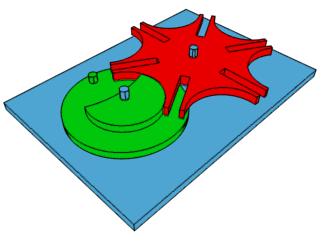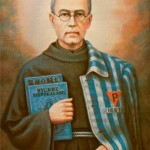When I was in school, it wasn’t uncommon for my teachers to have access to smart whiteboards and computers, but it was seldom that there seemed to anything useful to do with them. But dy/dan, a math teacher and blogger, has a great project for students, where they designed their own vases and then tried to plot the rate at which the water level would rise in their classmates’ designs. Reading his post makes me want to putter around with the problem.
Meanwhile, in other fascinating modelling problems, I found, via MBlume, this animation that explains how constant rotational motion can be translated into intermittent motion (i.e. how your second hand gets its tick). It’s called the Geneva Drive.
Reading the wikipedia page, I found out this is also how film projectors used to advance one frame at a time.
The Geneva Device is the answer to a question I never asked. Over at Scottbot, Scott wonders how many other questions about the past we’re missing the answers to because we’re neglecting cross-disciplinary questions. He tells the story of a Gutenberg mystery and then goes on to say:
At the end of his talk, Blaise made an offhand comment: how is it that historians/bibliographers/librarians have been looking at these Gutenbergs for so long, discussing the triumph of their identical characters, and not noticed that the characters are anything but uniform? Or, of those who had noticed it, why hadn’t they raised any red flags?
The insights they produced weren’t staggering feats of technology. He used a nice camera, a light shining through the pages of an old manuscript, and a few simple image recognition and clustering algorithms. The clustering part could even have been done by hand, and actually had been, by Paul Needham. And yes, it’s true, everything is obvious in hindsight, but there were a lot of eyes on these bibles, and odds are if some of them had been historians who were trained in these techniques, this insight could have come sooner. Every year students do final projects and theses and dissertations, but what percent of those use techniques from outside historiography?
In short, there’s a lot of very basic assumptions we make about the past that could probably be updated significantly if we had the right skillset, or knew how to collaborate with those who did. I think people like William Newman, whoperforms Newton’s alchemical experiments, is on the right track. As is Shawn Graham, who reanimates the trade networks of ancient Rome using agent-based simulations, or Devon Elliott, who creates computational and physical models of objects from the history of stage magic. Elliott’s models have shown that certain magic tricks couldn’t possibly have worked as they were described to.
Columbia’s magazine has a nice feature on a researcher who tried to study the United States’ approach to classifying information without relying on leakers, but just by taking a careful look at the gaps in what was available:
Then Connelly had an idea: could he use data mining to infer what types of information were being left out of the public record? In theory, this seemed plausible, if he could compile enough materials to work with. He figured he could start by asking Columbia Libraries to give him special access to several commercial databases that the University licenses from academic publishers and which contain federal records. He could then download a wealth of material from government websites. Maybe he could even gather up documents that fellow scholars, journalists, and citizens had acquired directly from the government under the Freedom of Information Act (FOIA). No one had ever tried to analyze the entire corpus of government records as one big database before. The promise of data mining now made it seem like a worthwhile endeavor to Connelly. He thought that if he were to recruit an interdisciplinary team of data analysts and fellow historians, he might create the first system for highlighting gaps in the National Archives. Perhaps this would even shame the government into releasing more classified materials.
I also enjoyed this story of tracking down hidden data… well, technically people. Wired has a fascinating profile of a skip tracer — a woman who is the real life equivalent of Boba Fett.
At 4’11” and just over 100 pounds, Michelle Gomez doesn’t look like the sort of person you’d hire to retrieve earthmoving equipment stolen by a Peruvian crime family. But in the summer of 2013, that’s exactly what she was doing.
Gomez, the proprietor of a one-woman operation in Lockhart, Texas, called Unlimited Recoveries, is one of the best skip tracers in the world. A combination bill collector, bounty hunter, and private investigator, a skip tracer finds people and things that have disappeared on purpose. Gomez specializes in “hard-to-locate recoveries”—she prefers cases others can’t solve. To track down the fleet of Caterpillar wheel loaders taken by the Peruvians, Gomez reached out to the estranged wife of the family’s patriarch, telling the woman that she was pregnant with her husband’s child. The ruse worked: Eventually the wife told Gomez that the heavy equipment was on its way to a construction site in South America.
But some mysteries that researchers explore are a little more quotidian. Business Insider has the video coverage on a study that tried to pin down what male dance moves were most alluring.
Pretty much no progress on the Halloween costume front (I was only at home Tues-Thurs this week — travelling to see my brother in a Midsummer variant and for an alumni debate). So I really need to work on altering the pattern next week. In the meantime, and apropos of the preceding quick take, here’s a bunch of people with finished costumes who are awfully happy about what they’ve put together:
Today is the second day of my novena to St. Maximilian Kolbe. Free free to pray along.
For more Quick Takes, visit Conversion Diary!














